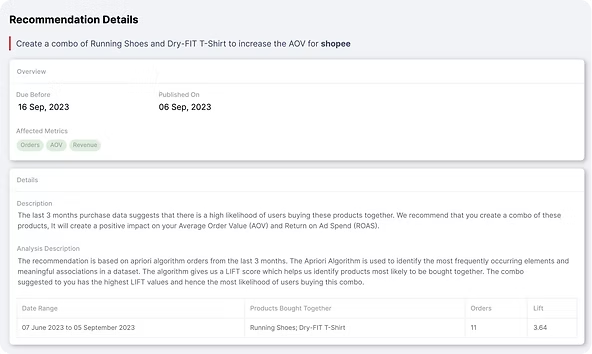
Marketplaces have become a go-to channel for businesses of all sizes to promote their products in order to reach their audience faster.
They are the modern-day marketplaces, where shoppers gather to explore a wide range of products, and for brands, they represent an unmatched opportunity to not only get noticed but also to accelerate their journey to the wallets of their ideal customers.
Forbes has predicted that marketplace sales will surpass $3.5 trillion by 2024. By 2027, two-thirds of the total online sales will come from marketplaces, making it the fastest-growing retail channel.
But with every brand using the same set of strategies, a fundamental question arises: How do you transform your listings into a steady stream of profitable sales?
This post shares tactics you can use to make the most of marketplace listings.
Here are seven key strategies that maximize your marketplace revenue and promise to drive your brand's success:
Optimizing your product listings for each marketplace is one of the most fundamental strategies to boost revenue.
Whether it's Amazon, eBay, Lazada, or Shopee, each marketplace employs a unique search algorithm and ranking criteria to determine which products appear first to their audience.
To maximize your visibility and, consequently, your marketplace revenue, it's crucial to tailor your listings to meet the specific requirements set by marketplaces. And this should include:
Apart from these, you should also make changes based on upcoming seasons and popular occasions like BFCM or Double Day Sales. For example, if you generally sell lights as a home decor product, during Christmas, you can optimize the product title and description with the “Christmas lights” keyword.
By optimizing your marketplace listings, you improve your chances of appearing higher in search results, attracting more potential customers, and ultimately increasing your sales and revenue on each marketplace.
If you want to maximize your marketplace revenue while also retaining customers, you must provide your customers with an exceptional shopping experience. A great way of offering this is via in-marketplace live chat support.
By providing live chat support, you allow your customers to ask questions, seek product recommendations, and resolve issues in real-time. This helps potential buyers make informed decisions and reduces the likelihood of them leaving your listing to explore competitors.
And when your customer support is quick and effective, it also builds trust and credibility, which are crucial for converting visitors into buyers. And 7 out of 10 shoppers purchase more from brands they trust.
There are more ways in which offering live chat support in the marketplace maximizes revenue:
Localization is a strategic approach that goes beyond the boundaries of personalization by connecting with customers on a cultural and regional level.
While personalization involves tailoring content to individual preferences, localization takes it a step further. It encompasses a multi-faceted strategy designed to resonate with local audiences, which increases conversion rates and maximizes revenue.
One key element of localization is aligning your content with the cultural nuances and linguistic preferences of your target market.
This means translating product listings, descriptions, and marketing materials into the local language, ensuring that your brand's messaging is comprehensible and relatable to your audience.
By speaking the buyer's language, you can break down language barriers and establish a deeper connection, building trust and credibility with local consumers.
Moreover, localization is not limited to using the local language. It extends to regional-specific promotions and campaigns. Brands that tap into local events, holidays, and traditions can create a stronger emotional bond with customers, which drives more engagement and sales during these peak periods.
When you incorporate localization into your marketplace management strategy, it shows a commitment to understanding and serving the unique needs and preferences of local markets. It creates a sense of belonging and relevance, ultimately driving higher conversions and eCommerce revenue growth.
Up-selling and cross-selling are strategic techniques to increase revenue by encouraging customers to buy more or upgrade their purchases.
So, how do they maximize the eCommerce marketplace revenue?
These strategies won’t make any sense if you’re bundling the wrong products together. This is where Graas comes in. It provides bundling recommendations that make up-selling and cross-selling more effective.
By analyzing customer behavior and preferences, Graas suggests product combinations that are likely to resonate with your target audience, which enhances your sales strategy.
Implementing upselling and cross-selling with Graas can boost revenue and enhance the overall customer experience by helping customers discover products that meet their needs or desires.
What a customer feels about your brand post-purchase matters a lot. If you provide a high-quality after-sale service, you can turn one-time buyers into loyal customers, driving repeat purchases and contributing significantly to your eCommerce profitability.
A positive post-purchase experience, including efficient order fulfillment, easy returns, and responsive customer support, again builds trust and encourages customers to return for future purchases. Repeat customers often spend 67% more, leading to increased revenue.
A great after-sale service ensures that your customers are delighted after purchasing from you. Those who have a positive experience with your brand are more likely to choose you over competitors, even if your prices are slightly higher than the other options on the marketplace.
Efficient post-purchase support can also help reduce returns, saving you money on return processing and restocking fees.
Settlement follow-up is a critical aspect of maximizing marketplace revenue that often goes overlooked. It involves reconciling and consolidating payments from multiple marketplaces to gain a complete view of returns and discrepancies directly impacting your profitability.
How it helps maximize marketplace revenue:
With Graas platform, you can simplify settlement consolidation, making it easier to track and manage payments across various marketplaces in one dashboard. Paying close attention to settlement details protects your revenue and helps you maintain a healthier bottom line.
For brands who want to drive in the competitive marketplace segment, data-driven marketing and advertising is an uncompromisable aspect. This approach involves analyzing performance dips and metrics across various dimensions, and using these insights to refine marketing strategies on marketplaces.
With Graas' Marketing Deep Dive, you can conduct a serious examination of your marketing performance across every channel, category, SKU (Stock Keeping Unit), and campaign. This level of granularity is essential for gaining insights beyond surface-level statistics. It allows eCommerce brands to see precisely where their efforts are paying off and where improvements are needed.

It examines performance metrics at multiple levels of granularity, including marketplace and sales channel analysis, marketing channel evaluation, and campaign-level scrutiny. By doing so, brands get a clear view of the effectiveness of their marketing efforts.
For instance, analyzing performance data can reveal which marketplace or sales channel generates the most visibility and revenue. This insight allows brands to allocate resources more effectively, concentrating efforts where they yield the best results.
Moreover, data-driven marketing also gives you a better understanding of what messaging and discount strategies tend to drive higher sales. Knowing which promotions resonate with your audience allows brands to create their messaging for maximum impact.
A significant part of marketing relies on visuals. They entice buyers, and data analysis can give you insights into the most effective visuals. Whether it's product images, ad creatives, or video content, this information helps brands create more visually appealing and engaging marketing materials.
Online marketplaces are evolving with each passing day. And getting success here depends on data-driven strategies. From optimizing listings to offering exceptional experiences, these above-mentioned strategies are crucial.
For those managing multiple channels, Graas simplifies the process. Its Marketplace Management solution centralizes workflows, streamlines operations, and provides valuable AI-driven analytics.
It allows you to access all marketplaces from one dashboard, managing listings, campaigns, inventory, orders, and fulfillment efficiently.
With growing competition, you need data to maximize your marketplace revenue. Graas unlocks this potential for you.